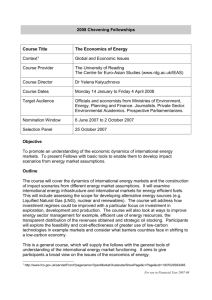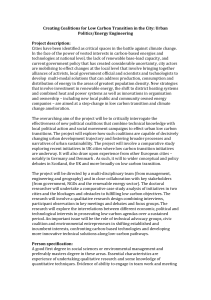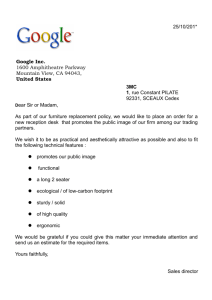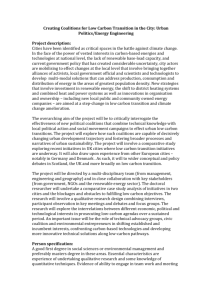UNCTAD Multi-Year Expert Meeting on Commodities and Development 2013
advertisement
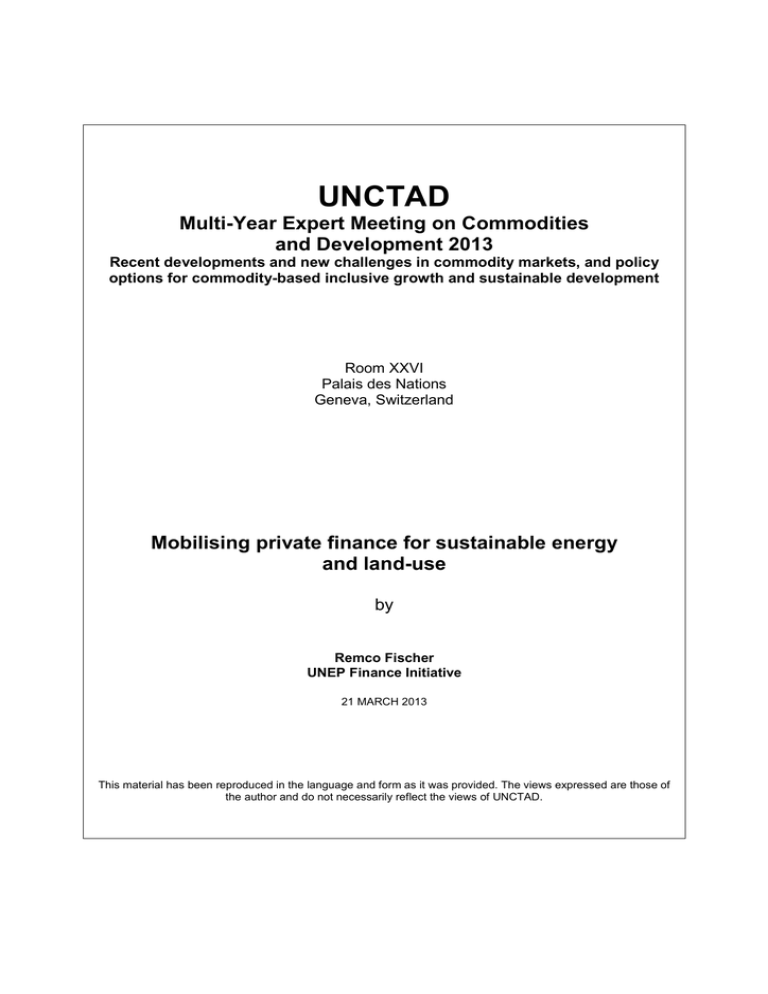
UNCTAD Multi-Year Expert Meeting on Commodities and Development 2013 Recent developments and new challenges in commodity markets, and policy options for commodity-based inclusive growth and sustainable development Room XXVI Palais des Nations Geneva, Switzerland Mobilising private finance for sustainable energy and land-use by Remco Fischer UNEP Finance Initiative 21 MARCH 2013 This material has been reproduced in the language and form as it was provided. The views expressed are those of the author and do not necessarily reflect the views of UNCTAD. Multi-year Expert Meeting on Commodities and Development Mobilising private finance for sustainable energy and land-use. Remco Fischer UNEP Finance Initiative The private sector – why? The technology innovation continuum: 85% Source: UNEP SEFI, 2009 The private sector – what? The ‘Private Sector’ is a very broad term: in the context of REDD+, we can think of two main private sector groups Explicit Producers of Emissions Reductions Arguably the ‘traditional’ view of REDD+- production of Emission Reductions Private sector actors might include Providers of up-front finance Implementers, project development Providers of technical advice and services Buyers of carbon or other associated products Volume of carbon credits is one indicator of size. 26 MtCO2 transacted in the voluntary market in 2011 with a value of USD 237 million Agriculture accounts for around 80% of global forest loss Drivers vary considerably but the main ‘forest-loss’ commodities are: Supply chains of ‘forest-risk’ commodities Palm oil, soy, beef Supply chains include: Input providers, farmers, processers, traders, retailers and consumers Global soft commodity markets are very large- estimated producer value of these goods in tropical countries. Annual producer values*: Palm USD 31 billion, Soy USD 47 billion, Beef USD 14 billion Lenders and investors: why? Global new Investment in Sustainable Energy, USD billions The technology innovation continuum: 2 °C, 450 ppm $ 530 billion Soy supply chain example Lenders and investors: why? Seed production Dominated by Monsanto, Dupont & Syngenta. Growers Trading Crushing Highly fragmented; Dominated by 4 grown on family farms companies: ADM, and plantations. Size of Cargill, Bunge & Louis an average U.S. farm is Dreyfus 314 acres Key trends in the soy industry Highly consolidated into four main companies Most companies are vertically integrated and thus control other segments of the supply chain- traders often provide seed and credit to growers for example Geographical differences: Private firms located in Asia and Latin America Public firms located in the US and America 85% of all soybeans are crushed, with remaining used in food industries Meal / Oil / Food Primarily used for livestock feed and vegetable oils Potential entry points for FIs Banks as: Investors as: Providers of loans Underwriters of bond and stock offerings Research providers Equity investors- can be active (such as putting forward shareholder resolutions) or passive Holders of corporate bonds/debt Insurers as: Providers of commercial, market and political risk cover Private finance will likely be needed to close critical funding gaps. Global new investment in renewable energy: developed v developing countries, 2004-2011, USD billion Renewable energy Source: UNEP / Bloomberg New Energy Finance (2012) USD 135 billion Private finance might be needed to close critical funding gaps. + Adaptation USD 65 - 100 billion + REDD+ / land - use USD 20 - 40 billion Renewable energy USD 45 - 100 billion Private finance might be needed to close critical funding gaps. Annual requirements Multi year total: represents all pledges since 2008 Financing change. Smart public intervention to mobilise financial institution skills and resources for sustainable development. – Sustainable development: low-carbon, climate-resilient development – Two critical ‘sectors’ for mitigation: (i) energy; (ii) land use – How can national governments mobilise private finance for sustainable, low-carbon energy and land-use? – How can the international community (UNFCCC regime) support this unlocking of private climate finance? How can governments and the international community mobilise private climate finance? UNEP FI study 38 energy infrastructure financiers surveyed Recommendations Private finance mobilisation to deploy climate mitigation technologies in developing countries will require national governments and the international community to address three critical barriers: 1. No level playing field between high-carbon and low-carbon investment alternatives 2. Regulatory barriers in developing countries. In the energy sector, for instance, there is often no easy market/grid access for low-carbon technologies 3. Political and regulatory investment risks 1. BARRIER: No ‘level playing field’ between high-carbon and low-carbon investment alternatives: – Sustainable, low-carbon technologies and infrastructure are typically more expensive, despite fastly becoming increasingly competitive – High capital intensity of low-carbon energy options in a challenging risk landscape: high CAPEX and low OPEX of renewable energy versus low CAPEX and high OPEX of fossil-fuel-based generation – Higher transaction costs – Fossil fuel subsidies 1. BARRIER: No ‘level playing field’ between high-carbon and low-carbon investment alternatives: Levelised cost of electricity for different generation technologies, Q1 2012 V Q1 2011, USD per MWH Source: UNEP / Bloomberg New Energy Finance 1. SOLUTION: Create a level playing field in terms of profitability, between innovative and promising low-carbon technologies and conventional, but cheaper high-carbon options. Source: UNEP Finance Initiative 1. SOLUTION: Create a level playing field in terms of profitability, between innovative and promising low-carbon technologies and conventional, but cheaper high-carbon options. – Formulate national energy visions with clear renewable energy and energy efficiency targets -------- ZERO COST. – Put in place credible and stable (not overly generous!) incentive mechanisms for renewable energy and energy efficiency technologies and infrastructure ------- SOME COST. – Phase out fossil fuel subsidies to fund the required incentive mechanisms for sustainable energy -------- ZERO COST. 1. SOLUTION? Create a level playing field – the CDM – Problem with Option 1: ‘public interventions at national level’ hinge on national institutions, readiness and willingness, on a country by country basis – The CDM is different: a global mechanism accessible to all developing countries; legal, regulatory and institutional requirements are reasonable – Main benefit of the CDM: it exists, in fully operational form, already! Existing systems, governance, process and institutional infrastructure (DNAs, DOEs, EB, etc.) in place! Existing industry in place (financiers, project developers, certifiers etc.) – The CDM covers the incremental cost of low-carbon investment options from polluters in developed countries, rather than from tax-payers. 3. BARRIER: Political and regulatory investment risks, particularly… I. Country and political risk II. Low-carbon policy risk III. Currency risk 3. SOLUTION: Mitigate political and regulatory investment risk which continue to be detrimental, particularly for sustainable technologies, even in situations where a level playing field and easy market access have been established. I. Country and political risk ‘CLIMATE MIGA’ II. Low-carbon policy risk ‘CLIMATE MIGA’ III. Currency risk ‘CLIMATE CURRENCY FUND’ Changing finance. Changing the DNA of financial markets. – Reaching the situation where in all decisions appropriate space and weight is given to relevant environmental, social and governance (ESG) factors. – Critical: availability, accessibility and systematic integration of ESG information. – Two categories of information: (i) greenhouse gas emissions, (ii) resilience to physical impacts Carbon integration and disclosure. Improving the availability and accessibility of greenhouse gas information, as well as its systematic integration by finance institutions –2/3 of Fortune 500 FIs now report on Scope 1 and 2 emissions –Real challenge: Scope 3 that includes emissions associated with loans and investments –3-year project in partnership with the GHG Protocol to develop guidance for FIs on the recent Scope 3 Standard of the GHGP Thank you. Remco Fischer, UNEP Finance Initiative Remco.Fischer@unep.org Multi-year Expert Meeting on Commodities and Development

